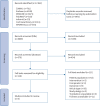Increasing physical activity in severe asthma: a systematic review and meta-analysis
- PMID: 35896208
- PMCID: PMC9753478
- DOI: 10.1183/13993003.00546-2022
Increasing physical activity in severe asthma: a systematic review and meta-analysis
Abstract
Introduction: Physical inactivity is common in asthma and is recognised as an important modifiable risk for poor clinical outcomes such as impaired asthma control and health-related quality of life (HRQoL). Despite evidence supporting the role of physical activity in reducing the risk of these outcomes, little is known about optimal interventions for increasing physical activity in those with severe disease. This systematic review and meta-analysis evaluates the effectiveness of interventions in increasing physical activity in severe asthma.
Methods: MEDLINE, the Cumulative Index to Nursing and Allied Health Literature, Embase, PubMed, Informit, SPORTDiscus and Cochrane databases were searched up to September 2021 for physical activity-based intervention studies that assessed physical activity outcomes (e.g. steps per day, time spent undertaking physical activity) in adults with severe asthma. Data on asthma-related (e.g. asthma control) and health-related outcomes (e.g. HRQoL) were assessed as secondary outcomes. The revised Cochrane Risk of Bias tool was used to assess risk of bias. Random-effects meta-analyses synthesised data where possible.
Results: Four randomised controlled trials (all 12 weeks in duration) including 176 adults with moderate-to-severe asthma were included. An increase in physical activity was reported with a moderate-vigorous intensity aerobic and resistance training intervention (steps per day and time spent undertaking physical activity), and an unsupervised pedometer-based intervention (steps per day). Meta-analyses showed that physical activity interventions had an overall positive effect on steps per day (mean difference (MD) 1588, 95% CI 399-2778; p=0.009, I2=23), asthma control (MD -0.65, 95% CI -0.95--0.35; p<0.0001, I2=0%) and HRQoL (MD 0.56, 95% CI 0.10-1.01; p=0.02, I2=16%) compared to control.
Conclusion: While there is some evidence supporting the effectiveness of interventions in improving physical activity in adults with severe asthma, higher-quality, large-scale studies of longer duration are needed to determine the optimal intervention.
Copyright ©The authors 2022.
Conflict of interest statement
Conflict of interest: R.F. McLoughlin, V.L. Clark and P.D. Urroz have nothing to disclose. P.G. Gibson reports lecture honoraria from GSK, outside the submitted work. V.M. McDonald reports grants from GSK, AstraZeneca, NHMRC, Ramaciotti Foundation, MRFF and JHH Charitable Trust, outside the submitted work; and also reports the following leadership roles: Co-Director NHMRC Centre of Research Excellence in Treatable Traits, Co-Director NHMRC Centre of Research Excellence in Severe Asthma, Co-Director Priority Research Centre for Healthy Lungs, Co-Director Virus, Vaccines, Immumology and Asthma HMRI programme, Head of Research, School of Nursing and Midwifery, University of Newcastle and COPD-X Guideline.
Figures



References
Publication types
MeSH terms
LinkOut - more resources
Full Text Sources
Medical
